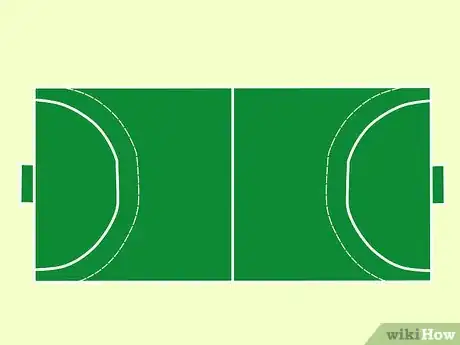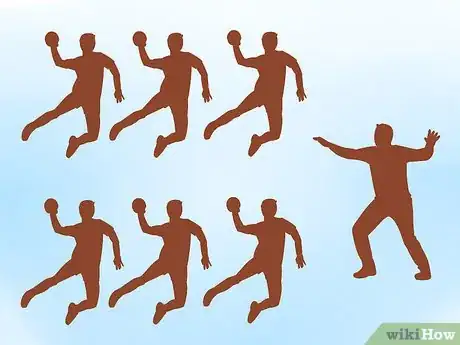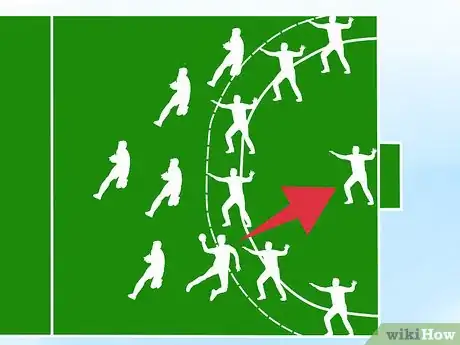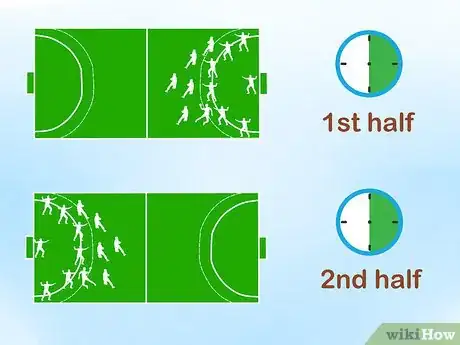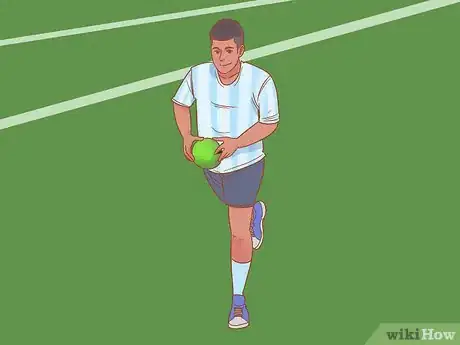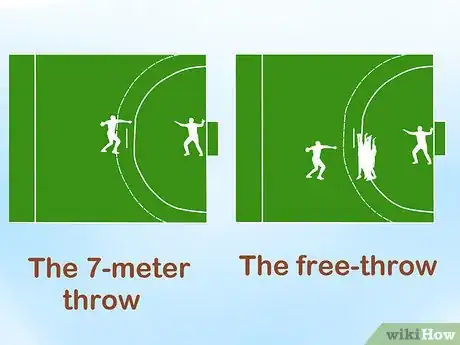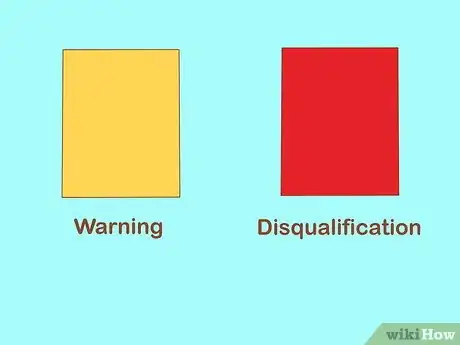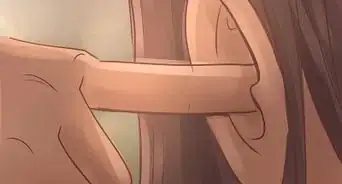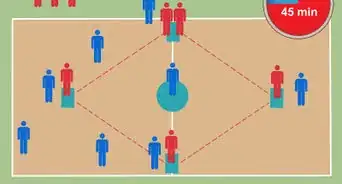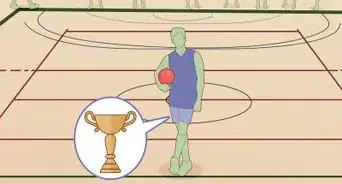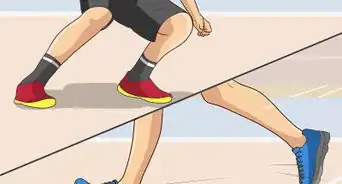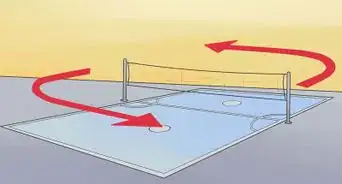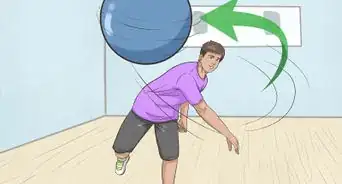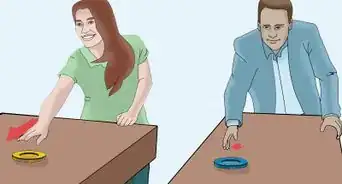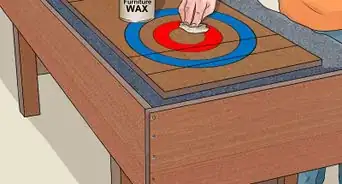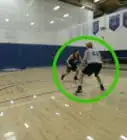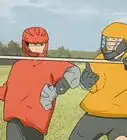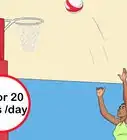wikiHow is a “wiki,” similar to Wikipedia, which means that many of our articles are co-written by multiple authors. To create this article, 42 people, some anonymous, worked to edit and improve it over time.
wikiHow marks an article as reader-approved once it receives enough positive feedback. This article received 12 testimonials and 84% of readers who voted found it helpful, earning it our reader-approved status.
This article has been viewed 366,544 times.
Learn more...
Handball is an exciting and fast-paced team game that is popular in Europe, which combines the techniques of soccer and basketball to create unique and competitive game play. To play team handball, each team has to shoot, dribble, and pass a ball in order to score goals over the opposing team. To play singles or doubles handball, which is more popular in America, you have to score against your opponent with the help of one, two, three, or four walls. If you want to know how to play either version of the game, see Step 1 below to get started.
Steps
Playing Team Handball
-
1Get familiar with the court. In team handball, the court is 20 meters (65' 7") by 40 meters (131' 3") large.[1] Here are some things you should know about the court:
- The court has a goal area line (also known as the crease), which is a 6-meter (19' 8") line where only the goalie is allowed to stand. The actual goal is 2 meters (6.6 ft) high and 3 meters (9.8 ft) wide. Players can only jump into the goal area if they release the ball before landing there.
- A dashed semi-circle that is 9 meters (29.5 ft) from the goal marks the free-throw line.
- The line at half court is also known as the center line.
- Get familiar with the ball, too. Traditionally, handball is played with a 32-panel leather ball. For women, the ball is 54–56 centimeter (21.3–22.0 in) wide and for men, it is 58–60 centimeter (22.8–23.6 in) wide and a bit heavier than the women's' ball.
-
2Form a team. There can be seven players on each team out on the court at any given time. One player on each team is the goalie and the remaining six are the court players.[2] Each team can have a total of 12 players (in America) or 14 players (in England) dress and play during a game. The additional players can substitute for the players on the court once the player they are substituting leaves the court, just as in basketball, volleyball, or other sports with substitutes. The non-goalie players' roles are interchangeable during the game.
- Players wear uniforms that are numbered 1-20. Each team's players should wear shirts and shorts of the same color, while each goalie wears a different color to stand out from the other teammates.
- In official games, there are always two referees, one for the court and one for the goal. Their decisions are final.
Advertisement -
3Understand the objective of the game. Each team scores points by throwing the ball into the opposing team's goal. The team that scores the most points wins the game. A game can end in a tie unless you're playing a tournament, which needs a winner to be named. If the game is tied after time runs out, then the teams play 2-5 minute periods of overtime.[3]
- A team can score a goal after the entire ball crosses the goal line and falls inside the goal. You can score a goal from any type of throw, which means the goal-throw, free-throw, throw-in, or throw-off (more information about these throws appears below).
-
4Play for the correct length of time. A traditional handball game is played in 2 30-minute halves with a 10 minute break in between. Youth or tournament games are shorter, played in 2 15-minute or 20-minute halves instead.[4]
- The time marked is the running time of the game. The only times the clock stops are for each team to have one time-out per half, and if there is an injury.
- At half-time, the teams switch benches.
-
5Understand what the field players can do. These players can touch the ball with all parts of their body above the knee (which means no kicking!). If they have the ball, they can only stay in place for three seconds (think of it as a traveling offense in basketball), and they can only move for three steps with the ball. If they do not follow these rules, the ball goes to the other team. The players must quickly decide whether to shoot the ball, dribble it, or pass it.[5]
- A player can dribble the ball for as long as he wants, just as long as he keeps his hand on top of the ball. After dribbling, he still gets the usual three steps/three seconds rule. If he dribbles again, that's a "double dribbling" violation and the ball goes to the other team.
- Other offenses that a player can commit include carrying the ball into the crease (the goalie's area), setting an illegal screen, and charging.
-
6Understand the different types of throws. Here's what you need to know about the different throws in the game:
-
The throw-off. The game starts with a throw-off. The throw-off takes place in the center of the court. Here, the thrower has to touch the middle line with one foot while all of the other players stay in their own half. The team that wins the coin toss and wants to start with the ball begins the throw off.
- After the whistle blows, the player with the ball in the center of the court passes the ball to a team-mate and play starts.
- Every time a goal is scored, the opposing team gets the ball for another throw-off. A throw-off also occurs after half-time.
- The throw-in. If the ball leaves play, then the team that didn't touch the ball last gets a throw-in.
- The free-throw. A free-throw is given after there's an interruption in play, and takes place wherever the play was interrupted. Play can be interrupted when one player is holding, pushing, hitting, tripping or hurting the other team's player and receives a penalty.
- The referee throw. A referee throw is called for when the ball touches anything that is above the court after multiple rules are broken during simultaneous possession of the ball. In this situation, the referee stands at center court and throws the ball vertically, between two players of opposing teams, and they must jump and grab the ball or tap the ball to a member of their own teams. Other members of the team must be at least 3 meters (9.8 ft) away from the throw.
- The 7-meter throw. This throw is given when a foul destroys a clear chance to score, the goalie carries the ball back to his own area, a court player plays the ball to his own goalie, or a defensive player enters his own goal area. For this throw, all players have to be outside the free-throw line and the player who takes the throw has three seconds to shoot the ball.
- The goal-throw. This one is given when the ball rebounds off the goalie over the end line or if the ball is thrown over the end line by the team that is attacking. For this throw, the goalie throws the ball from his area and does not have to follow the three step/3 second rule.
-
The throw-off. The game starts with a throw-off. The throw-off takes place in the center of the court. Here, the thrower has to touch the middle line with one foot while all of the other players stay in their own half. The team that wins the coin toss and wants to start with the ball begins the throw off.
-
7Know the rule violations. There are many ways to commit a rule violation. If one team commits a violation, then that means that the other team is awarded the ball, either as a throw-in, free-throw, or goalie-throw. Here are the different violations:
- Passive play. This means keeping the ball within one team's possession without trying to attack or to score. This basically means stalling with the ball.
- Endangering an opponent with the ball.
- Pulling, hitting, or punching the ball of the hands of an opponent.
- Making contact with the ball below the knee.
- Diving on the floor for a ball that is rolling or not moving.
- Outstretching your arms or legs to push, hold, obstruct, trip, or hit the opponent or to charge into a defensive player.
-
8Understand how progressive punishments work. These punishments occur when something that a player does warrants more than just a free-throw, such as any rule violations that are aimed at an opponent instead of the ball. Here are the stages of progressive punishments:[6]
- A warning/yellow card. Each player can only receive one warning for a rule violation, and each team can only receive a total of three warnings.
- A 2-minute suspension. This is given for serious and repeated rule violations, illegal substitution, and unsportsmanlike conduct. You do not need a warning first to get a 2-minute violation. For this violation, the player sits out for 2 minutes and is not replaced, so his team has to play one player short.
- Disqualification/red card. A player is given this as an equivalent of three suspensions that last 2 minutes each. After the first 2-minute suspension, the player can be replaced.
- Exclusion. The exclusion is given for assault and the player is excluded for the rest of the game. This is a serious offense and this player's team is at a huge disadvantage because it has to play one player short for the rest of the game.
-
9Improve your game. There are many tips and tricks that can help you excel as a handball player, but the most important thing you can do is just to keep playing. Here are some things you can work on as you improve your game:
- To be a master handball player, you and your team should work on passing the ball to each other as much as you can. This is faster than dribbling and can get you to the goal more quickly.
- When you are defending, you can work on keeping your hands up so that you block shots as well as passing opportunities for the other team.
- When you're dribbling, work on using one hand to dribble while shielding the ball with your other hand to keep it safe from the opposing team.
- Most importantly, just keep practicing! The more you play, the better you'll be at handball.
Playing Singles or Doubles Handball
-
1Decide whether you are playing Chinese or American handball.[7] Both of these games are played with a much smaller ball than team handball. Most official games are played with a "small ball," or an "ace ball," while street games are commonly played with a "big ball," which is about the size of a racquetball.
- There are three versions of the game (four-wall, three-wall, and one-wall), and the game can either be played by two players, three players, or four players.
- Chinese is the easier of the two, in which the players bounce the ball against the ground once before it hits the wall, while in American, it doesn't bounce. If it doesn't make it in one bounce (Chinese), or if it bounces (American), it is the other player's turn to "serve".
-
2Decide on your rules. An example would be whether you want DBA (Double bounce American, where if it bounces twice, you must hit it American, used in Chinese), or DBC (American only, when the ball bounces twice, hit it Chinese).
- You might want to rule out flagging, where the opponent is allowed to distract you but not interfere with the ball, or if you're on a team with someone, you might want team saves (where one person on the team hits the ball up, it bounces, then the other person hits it American).
- This also goes with self-saves. You can have self-saves for either team or by yourself). You could even call Kings (none of the rules; just hitting it. Don't forget about "slams", where you can hit it as hard as you can).
-
3Play until you win. Usually, a player wins the game if he scores 7 points, but you can mix things up if you're playing a more casual game. Here are some other things to keep in mind as you're scoring the game:
- There is usually a set score for when there is a shutout (when the opponent has 0 points the entire time).
- The set score for shutouts when playing to 7 is 5. After the set score is decided, a player begins the game with a "volley" (throwing the ball either Chinese or American, depending on what you're playing).
- Now the other person must hit it. This decides who gets the ball first.
- The person that misses the ball after it bounces twice (once if playing Kings) will not serve first.
- The game continues in the same matter, only there is no volley; just serving.
Community Q&A
-
QuestionWhat happens during a seven meter throw?
 Community AnswerThe person throwing stands at the "seven meter" mark and waits for the referee to give them a sign. When he does, the thrower shoots.
Community AnswerThe person throwing stands at the "seven meter" mark and waits for the referee to give them a sign. When he does, the thrower shoots. -
QuestionAm I allowed to touch the ball with my other hand?
 Community AnswerIf you hit it off the ground and take it with both hands, you have 3 steps before you have to let go of the ball. You can't walk with the ball in your hand more than 3 steps without hitting it off the ground, passing to a teammate, or shooting towards the goal.
Community AnswerIf you hit it off the ground and take it with both hands, you have 3 steps before you have to let go of the ball. You can't walk with the ball in your hand more than 3 steps without hitting it off the ground, passing to a teammate, or shooting towards the goal. -
QuestionIs there any forward player in handball?
 Community AnswerPretty much everyone goes on attack when his/her team is in possession - but not all players are trained in attack. For example, defenders can score, but they don't do it as often.
Community AnswerPretty much everyone goes on attack when his/her team is in possession - but not all players are trained in attack. For example, defenders can score, but they don't do it as often.
Warnings
- Know your skills.⧼thumbs_response⧽
- Do not constantly volley side-arm. It is unhealthy for the arm when constantly being done, and can lead to serious arm injury.⧼thumbs_response⧽
- When allowing slams (or at any time), watch where the ball is. Sometimes it can travel at high speeds.⧼thumbs_response⧽
Things You'll Need
- Handball
- One ball/four wall court
- Someone to play with
References
- ↑ https://sportsknowhow.com/team-handball/rules/team-handball-rules.html
- ↑ https://www.rulesofsport.com/sports/handball.html
- ↑ https://www.rulesofsport.com/sports/handball.html
- ↑ http://usadth.tripod.com/rules.html
- ↑ http://usadth.tripod.com/rules.html
- ↑ http://usadth.tripod.com/rules.html
- ↑ https://www.topendsports.com/sport/list/handball-chinese.htm
About This Article
To play handball, start by gathering 2 teams of up to 7 players each and assigning each team a goal. Each team should then attempt to get the handball into the opposite goal by touching the ball with any body part above the knee. As players move around the court, they can dribble the ball, pass it to another player, or throw it into the goal. Finally, the team that has the most points at the end of two 30-minute periods of play wins the game. To learn how to use different types of throws in handball, read on!
